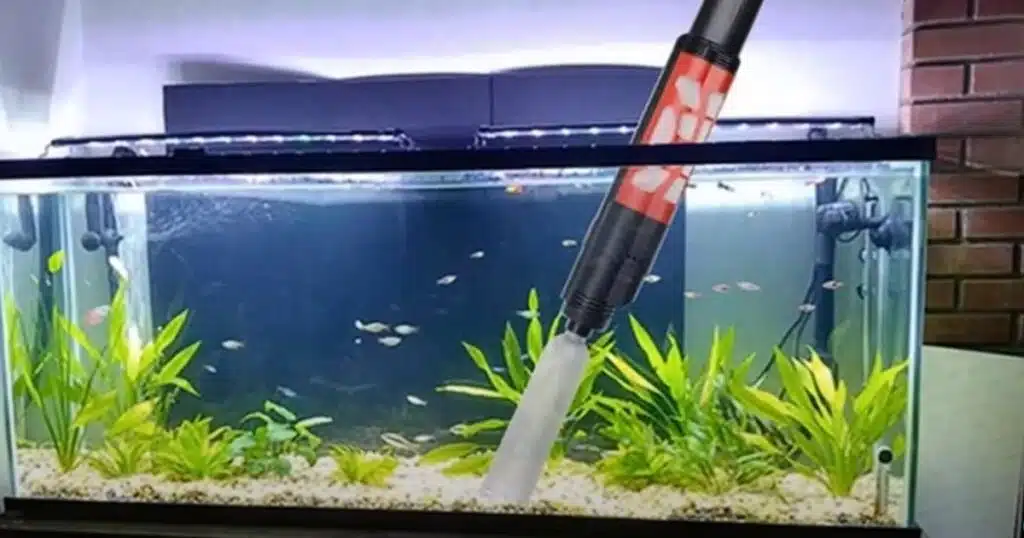As an Amazon Associate I earn from qualifying purchases.
Fish tank gravel serves as a crucial component of the aquarium ecosystem, providing a substrate for beneficial bacteria and a habitat for aquatic plants.One important aspect of tank maintenance is vacuuming the gravel to remove waste and debris. But how often should you do this? In this post, we’ll discuss the best practices for vacuuming gravel in your fish tank to ensure a clean and healthy environment for your fish.

Importance of Gravel Vacuuming
Gravel vacuuming is an essential task in maintaining a healthy and clean fish tank environment. Regular vacuuming helps remove waste and debris that can accumulate in the gravel, preventing the build-up of harmful bacteria and toxins. It also helps to maintain water quality and clarity, ensuring a healthy and thriving aquatic ecosystem for your fish. By vacuuming the gravel regularly, you can also prevent the formation of algae and other unsightly substances, keeping your tank looking clean and attractive. Overall, gravel vacuuming is a crucial part of fish tank maintenance that promotes the well-being of your aquatic pets and creates a visually appealing aquarium environment.
Factors Influencing Vacuuming Frequency
But how often should you vacuum? Well, it depends on a few things. Let’s talk about the factors that influence how often you need to vacuum your gravel.
Tank Size: If your fish tank is big, it might need less frequent cleaning. That’s because there’s more water to spread out the mess. Smaller tanks require more vacuum than larger.
Quantity of fish: More fish means more waste. So, if you have a lot of fish swimming around, you’ll probably need to clean the gravel more often to keep the water clean.
Feeding Habits: Do you feed your fish a lot? If you do, there might be more leftover food in the gravel. Leftover food can make the tank water more dirtier faster, so you might need to clean it more often.
Fish Type: Different types of fish produce different amounts of waste. Some fish are messier than others, so their tanks might need more frequent cleaning.
Gravel Appearance: Take a look at your gravel. Does it look dirty? If it does, it’s probably time to clean it. Trust your eyes – if it looks dirty, it probably is!
So, these are the things that influence how often you should vacuum your fish tank gravel. Keep them in mind and adjust your cleaning schedule accordingly. Your fish will thank you for it!
Step-by-Step Guide to Vacuuming Gravel
Prepare your equipment: Before you start vacuuming the gravel in your fish tank, gather all the necessary equipment. You will need a gravel vacuum, a bucket, and a siphon hose.
Begin the vacuuming process: Insert the gravel vacuum into the tank and start the siphon process. Move the vacuum through the gravel, making sure to pick up any debris and waste that has accumulated. Be thorough in your cleaning, but be gentle to avoid disrupting the fish and plants.
Monitor the water level: As you vacuum the gravel, the water level in the tank will begin to decrease. Make sure to keep an eye on it and stop the siphon process before the water level gets too low. You can do this by pinching the hose to stop the flow of water.
Watch for Clean Water: Once all the dirty water is out, you can clean the bucket and get it ready for next time.
Monitor your fish: After you have finished vacuuming the gravel and replaced the water, keep an eye on your fish to make sure they are not stressed by the cleaning process. If necessary, you can add some water conditioner to the tank to help reduce any stress on the fish.
Repeat as necessary: The frequency of gravel vacuuming will depend on the size of your tank, the number of fish, and the amount of waste they produce.
By following this step-by-step guide, you can keep your fish tank gravel clean and provide a healthy environment for your aquatic pets.
Recommended Vacuuming Schedule
A good rule of thumb is to vacuum the gravel every one to two weeks, depending on the size of your tank, the number of fish, and the amount of waste they produce. As you vacuum the gravel, monitor the water level in the tank and stop the siphon process before the water level gets too low. Once all the dirty water is out, clean the bucket and monitor your fish to make sure they are not stressed by the cleaning process. If necessary, you can add some water conditioner to the tank to help reduce any stress on the fish.
Tips for Effective Gravel Maintenance
- Avoid over-cleaning: While it’s essential to remove excess waste, be careful not to disturb the beneficial bacteria living in the substrate.
- Use a gravel vacuum with a suitable size: Choose a vacuum that matches the size of your gravel to ensure efficient cleaning without damaging the substrate.
- Incorporate live plants: Live plants can help maintain water quality by absorbing nutrients and providing natural filtration, reducing the need for frequent gravel vacuuming.
Conclusion
Regular maintenance of your fish tank gravel is vital for creating a healthy environment for your aquatic pets. By understanding the factors influencing vacuuming frequency and following proper techniques, you can ensure a thriving aquarium ecosystem for years to come.
Amazon and the Amazon logo are trademarks of Amazon.com, Inc, or its affiliates.
Leave a Reply